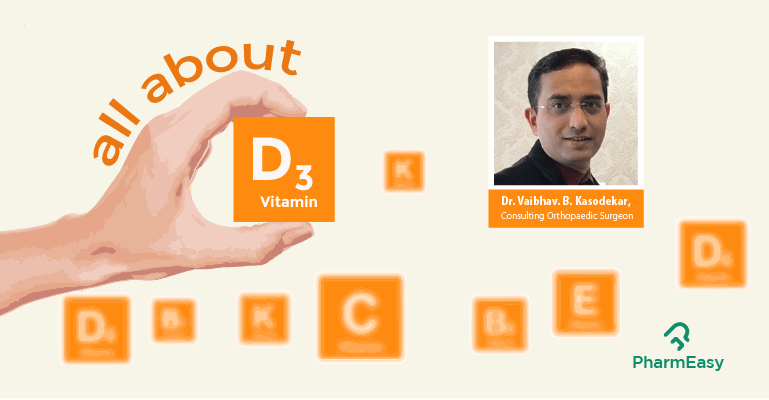Vitamin D Deficiency: How To Deal With It
By Dr. Nikita Toshi +2 more

Get,

to manage your symptom
Get your,


4 Cr+ families
benefitted

OTP sent to 9988776655



You’ve successfully subscribed to receive
doctor-approved tips on
Whatsapp

Get ready to feel your best.

Hi There,
Download the PharmEasy App now!!


Register to Avail the Offer
Send OTPBy continuing, you agree with our Privacy Policy and Terms and Conditions

Hi There,
Sign up on PharmEasy now!!
Trusted by 4 crore+ families

OTP sent to 9988776655



You have unlocked 25% off on medicines




Code: NU25
By Dr. Nikita Toshi +2 more
There are diseases that are emerging in the 21st century and Vitamin D deficiency is one of them. There are a lot of misconceptions regarding Vitamin D deficiency, its diagnosis and management, this blog aims to clear all those.
Any disease can be better understood by asking questions and getting satisfying answers for the same. The following FAQs will help you understand about Vitamin D deficiency and about its treatment.

Table of Contents
Vitamin D is a fat-soluble vitamin. Vitamin D promotes calcium absorption in the gut and maintains adequate serum, calcium, and phosphate concentrations to enable normal mineralization of bones. It is also needed for bone growth and bone remodeling. Without sufficient vitamin D, bones can become thin, brittle, or misshapen. Vitamin D sufficiency prevents rickets in children and osteomalacia in adults. Together with calcium, vitamin D also helps protect older adults from osteoporosis.
Vitamin D deficiency doesn’t always cause symptoms. When it does, some of the symptoms may include:
Vitamin D requirements cannot ordinarily be met by human milk alone. Exclusively and partially breastfed infants should be supplemented with 400 International Units (IU) of vitamin D per day.
Older adults are at an increased risk of developing vitamin D deficiency in part because, as they age, skin cannot synthesize vitamin D as efficiently, they are likely to spend more time indoors and they may have inadequate intakes of the vitamin.
Homebound individuals, women who wear long robes and head coverings for religious reasons and people with occupations that limit sun exposure are unlikely to obtain adequate vitamin D from sunlight. Because the extent and frequency of the use of sunscreen are unknown, the significance of the role that sunscreen may play in reducing vitamin D synthesis is unclear.
Greater amounts of the pigment melanin in the epidermal layer result in darker skin and reduce the skin’s ability to produce vitamin D from sunlight.
Because vitamin D is a fat-soluble vitamin, its absorption depends on the gut’s ability to absorb dietary fat. Individuals who have a reduced ability to absorb dietary fat might require vitamin D supplementation. People who are obese or who have undergone gastric bypass surgery.
A body mass index ≥ 30 is associated with lower serum 25(OH) D levels compared with the non-obese individuals.
Foods that provide vitamin D include:
Vitamin D, as either D3 or D2, does not have significant biological activity. Rather, it must be metabolized within the body to the hormonally active form known as 1, 25-dihydroxycholecalciferol. This transformation occurs in two steps:
The most accurate way to measure how much vitamin D is in your body is the 25-hydroxy vitamin D blood test. A level of 20 nanograms (ng)/millilitre (mL) to 50 ng/mL is considered adequate for healthy people. A level of less than 12 ng/mL indicates vitamin D deficiency.
Fasting is not necessary to obtain a vitamin D level; however, getting blood tests at the same time makes sense, reducing the burden of time on the patient.
For people with vitamin D deficiency, treatment may include oral ergocalciferol (vitamin D2) at 60,000 IU per week for eight weeks. After vitamin D levels normalize, experts recommend maintenance doses of cholecalciferol (vitamin D3) at 800 to 1,000 IU per day from dietary and supplemental sources.
Vitamin D toxicity should not be diagnosed solely on the basis of an elevated 25(OH)D level; instead, it should be recognized as a clinical syndrome of both hypervitaminosis D and hypercalcemia, in which hyperphosphatemia and hypercalciuria also commonly (although not always) occur. Patients with vitamin D toxicity could be present with clinical symptoms and signs of hypercalcemia (e.g. nausea, dehydration, and constipation) and hypercalciuria (e.g., polyuria and kidney stones).
Written By:

Dr Vaibhav. B. Kasodekar is a Consulting Orthopaedic Surgeon at Jaslok Hospital & Research Centre. He has secured degrees of M.S. (Ortho), DNB (Ortho), FCPS, D.Ortho and has a fellowship in joint replacement and arthroscopy surgery from North America and Singapore. He has been practicing orthopaedics for the past several years and is one of the most sought doctors by renowned hospitals and medical institutions of the country.
Disclaimer: The information provided here is for educational/awareness purposes only and is not intended to be a substitute for medical treatment by a healthcare professional and should not be relied upon to diagnose or treat any medical condition. The reader should consult a registered medical practitioner to determine the appropriateness of the information and before consuming any medication. PharmEasy does not provide any guarantee or warranty (express or implied) regarding the accuracy, adequacy, completeness, legality, reliability or usefulness of the information; and disclaims any liability arising thereof.
Links and product recommendations in the information provided here are advertisements of third-party products available on the website. PharmEasy does not make any representation on the accuracy or suitability of such products/services. Advertisements do not influence the editorial decisions or content. The information in this blog is subject to change without notice. The authors and administrators reserve the right to modify, add, or remove content without notification. It is your responsibility to review this disclaimer regularly for any changes.

Leave your comment...
Comments